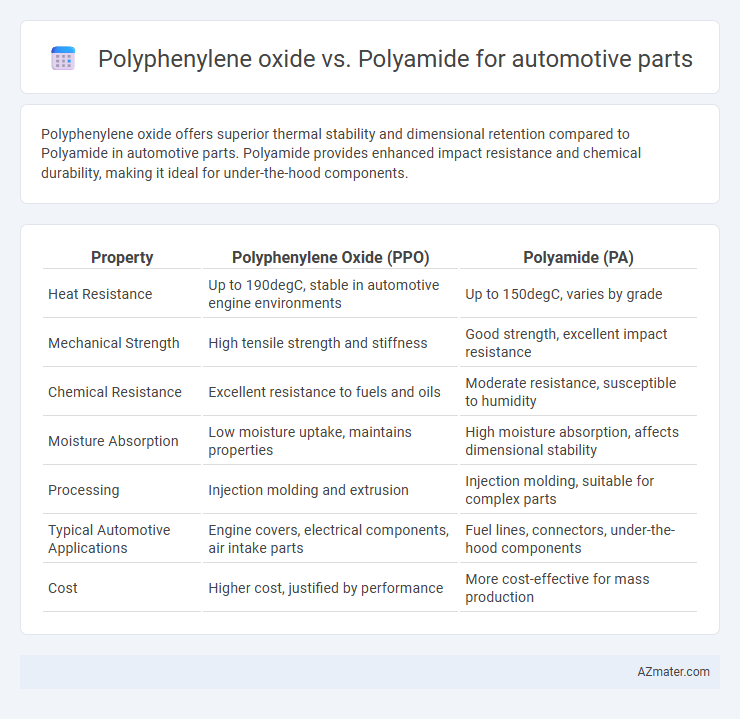Polyphenylene oxide offers superior thermal stability and dimensional retention compared to Polyamide in automotive parts. Polyamide provides enhanced impact resistance and chemical durability, making it ideal for under-the-hood components.
Table of Comparison
| Property | Polyphenylene Oxide (PPO) | Polyamide (PA) |
|---|---|---|
| Heat Resistance | Up to 190degC, stable in automotive engine environments | Up to 150degC, varies by grade |
| Mechanical Strength | High tensile strength and stiffness | Good strength, excellent impact resistance |
| Chemical Resistance | Excellent resistance to fuels and oils | Moderate resistance, susceptible to humidity |
| Moisture Absorption | Low moisture uptake, maintains properties | High moisture absorption, affects dimensional stability |
| Processing | Injection molding and extrusion | Injection molding, suitable for complex parts |
| Typical Automotive Applications | Engine covers, electrical components, air intake parts | Fuel lines, connectors, under-the-hood components |
| Cost | Higher cost, justified by performance | More cost-effective for mass production |
Introduction to Polyphenylene Oxide and Polyamide
Polyphenylene oxide (PPO) is a high-performance thermoplastic known for its excellent dimensional stability, heat resistance up to 190degC, and inherent flame retardancy, making it ideal for automotive components requiring durability and electrical insulation. Polyamide (PA), commonly known as nylon, offers superior mechanical strength, chemical resistance, and impact toughness, with heat resistance typically ranging between 120degC and 150degC, often used in under-the-hood automotive parts. Both materials serve critical roles in automotive manufacturing, with PPO favored for applications demanding thermal stability and electrical properties, while polyamide is selected for structural integrity and resistance to wear and chemicals.
Chemical Structure and Composition Comparison
Polyphenylene oxide (PPO) features an aromatic polyether backbone, providing excellent thermal stability and dimensional stability due to its rigid molecular structure, which enhances its performance in automotive parts. Polyamide (PA), commonly known as nylon, consists of repeating amide groups (-CONH-) in its polymer chain, offering high mechanical strength and good chemical resistance but with higher moisture absorption compared to PPO. The ether linkages in PPO contribute to superior oxidation resistance, whereas the hydrogen bonding in polyamides leads to increased toughness and impact resistance under automotive operating conditions.
Mechanical Properties of PPO vs Polyamide
Polyphenylene oxide (PPO) offers superior dimensional stability and high impact resistance compared to polyamide, making it ideal for automotive parts exposed to mechanical stress. PPO exhibits excellent stiffness and maintains performance under thermal cycling, whereas polyamide typically shows higher tensile strength and better wear resistance. The choice between PPO and polyamide depends on the specific mechanical demands, with PPO favored for parts requiring rigidity and thermal aging resistance while polyamide suits applications needing toughness and abrasion resistance.
Thermal Stability in Automotive Applications
Polyphenylene oxide (PPO) demonstrates superior thermal stability in automotive applications compared to polyamide, maintaining mechanical integrity at temperatures exceeding 150degC. PPO's high glass transition temperature and inherent resistance to thermal oxidation enable it to withstand prolonged exposure to engine heat and under-the-hood environments. In contrast, polyamide (nylon) tends to absorb moisture, which can reduce its thermal performance and dimensional stability under elevated temperatures.
Resistance to Chemicals and Moisture
Polyphenylene oxide (PPO) offers exceptional resistance to a wide range of automotive chemicals, including fuels, oils, and brake fluids, maintaining structural integrity under prolonged exposure. Polyamide (PA), while also resistant to many chemicals, is more susceptible to moisture absorption, which can lead to dimensional changes and reduced mechanical properties in humid environments. PPO's low moisture absorption rate makes it more suitable than PA for automotive parts requiring high chemical and moisture resistance.
Processing Methods and Moldability
Polyphenylene oxide (PPO) offers excellent dimensional stability and ease of injection molding compared to polyamide, which requires more precise drying to avoid moisture-related defects during processing. Injection molding of PPO benefits from its low melt viscosity, enabling faster cycle times and finer detail reproduction, while polyamide often requires higher mold temperatures to ensure complete flow and optimal crystallinity. PPO's superior moldability allows for complex automotive parts with tight tolerances, whereas polyamide's processing favors parts demanding high mechanical strength and chemical resistance despite more challenging molding conditions.
Weight Reduction and Fuel Efficiency Benefits
Polyphenylene oxide (PPO) offers significant weight reduction advantages over polyamide due to its lower density and excellent thermal stability, making it ideal for automotive parts where lightweight materials improve fuel efficiency. PPO's superior dimensional stability and moisture resistance enhance durability without adding extra weight, contributing to longer-lasting components and reduced maintenance costs. The integration of PPO in automotive applications leads to improved fuel economy by decreasing vehicle mass and optimizing performance under varying temperature conditions.
Cost Analysis: Polyphenylene Oxide vs Polyamide
Polyphenylene oxide (PPO) typically incurs higher raw material costs than polyamide (PA), impacting overall budget considerations for automotive parts production. Manufacturing with polyamide offers cost advantages due to its widespread availability and established supply chains, resulting in lower per-unit expenses. However, PPO's superior thermal stability and resistance to chemicals can reduce long-term maintenance and replacement costs, potentially offsetting initial investment differences in automotive applications.
Typical Automotive Parts Made from PPO and Polyamide
Polyphenylene oxide (PPO) is commonly used in automotive parts such as electrical connectors, housings, and interior trim components due to its excellent dimensional stability, thermal resistance, and electrical insulation properties. Polyamide (PA), also known as nylon, is widely utilized in fuel system components, under-the-hood parts, and structural brackets because of its high mechanical strength, chemical resistance, and impact toughness. Both materials play critical roles in automotive manufacturing, with PPO favored for electrical applications and polyamide preferred for mechanical and chemical durability.
Future Trends and Innovations in Automotive Polymers
Polyphenylene oxide (PPO) and polyamide (PA) are advancing automotive polymer use due to their thermal stability and mechanical strength, essential for electric vehicle components and lightweight structural parts. Innovations in PPO focus on enhancing flame retardancy and chemical resistance, optimizing battery housings and under-the-hood applications. Polyamide developments prioritize bio-based variants and improved moisture resistance, promoting sustainability and durability in engine covers and fuel system components.

Infographic: Polyphenylene oxide vs Polyamide for Automotive part
 azmater.com
azmater.com